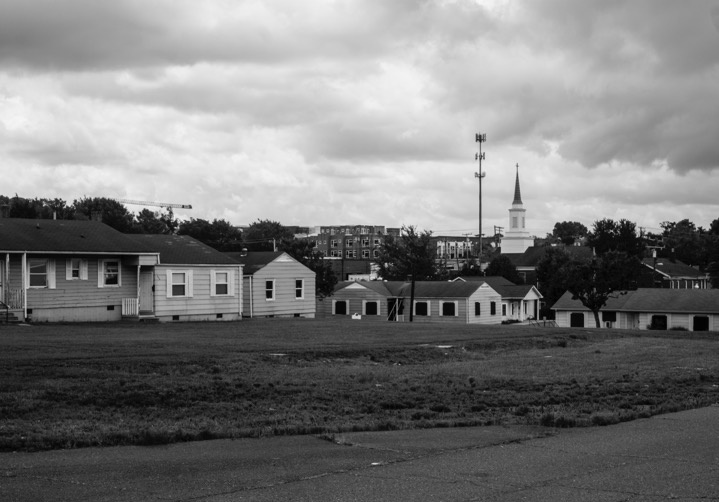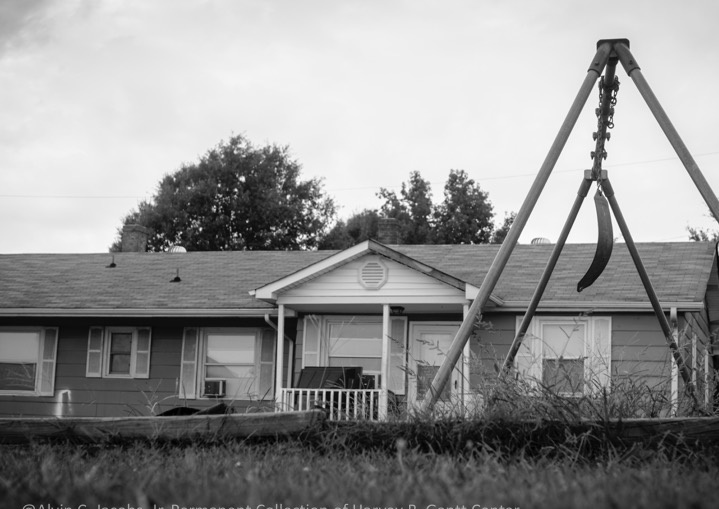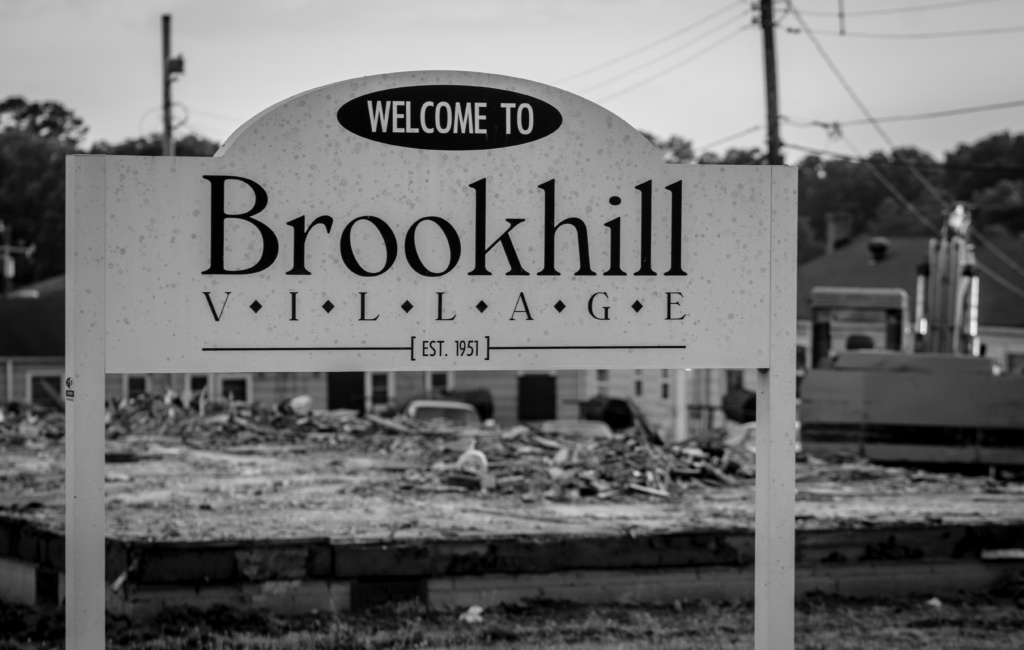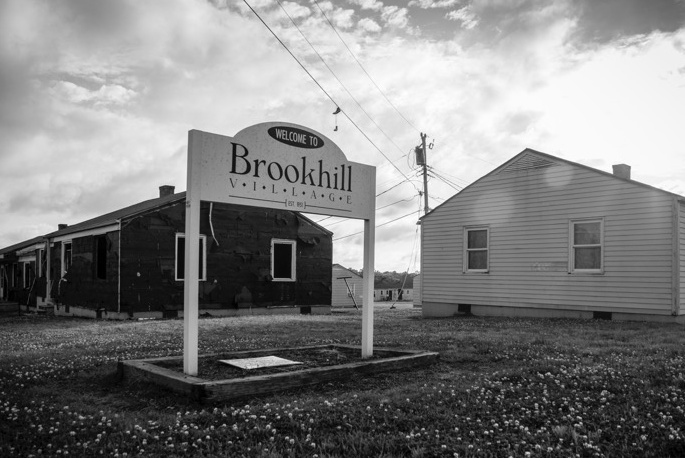 By Matt Cosper
By Matt Cosper
Cover photo: Alvin C. Jacobs, Jr. / Harvey B. Gantt Center
September 25, 2018 (updated)
Under the surface of our current gilded age there are rampant problems that affect vast numbers of Charlotteans in the most essential of arenas: what we eat, how we manage medical care, and how we keep a roof over our heads and those of our families. According to the Mecklenburg County Housing and Homelessness Dashboard it takes 96 hours a week at minimum wage to afford a two bedroom apartment in Charlotte. That constitutes a crisis.
While the city sparkles with high-dollar new development for the one percent, many average residents have been priced out, not to mention the effect of the real estate boom on the working poor. According to The Charlotte Observer average rent prices have jumped 30 percent in the last five years from $842 to $1142 a month. Purchasing a home is even less realistic for many Charlotteans with the median home price up to $235,000 in the region. And while property values go up wages are generally stagnant. It doesn’t take a genius to see that the math doesn’t work and that if things continue Charlotte will only be affordable for the most prosperous amongst us, with the rest of the city’s population pushed out.![]()

Something needs to be done. In a democracy that means that a government of the people and for the people acts to address the problems of all the citizens, not just the elite. And in this case, better late than never. To speak plainly: Charlotte’s city government got caught up in the excitement of the last several decades of development (with a certain former mayor and jailbird perhaps a little too eager to play ball with developers) and dropped the ball when it came to the little people. Now that we’ve reached a place of crisis, the city is acting aggressively to make sure that our low-income citizens have housing in the city and, by extension, access to the opportunities that come along with it. Actions taken include sale of land along the northern light rail corridor with specific guarantees from buyers that projects on these plots will include units for folks earning less than 80% of the local median (in June of 2018, according to The Observer, local median annual income is around $59,000 with a large percentage of people making much less than 80% of that).
In August the City Council approved “Framework for Building and Expanding Access to Opportunity Through Housing Investments,” a plan created in collaboration with national affordable housing non-profit Enterprise Community Partners. “Framework” suggests a broad spectrum of long- and short-term solutions to the crisis including strategic land purchases, accessing and directing federal block grants in community development toward creating mixed income housing, and ensuring that publicly funded housing developments set aside 20% of units to serve low-income citizens. The plan has been enthusiastically supported in the press by figures such as Ray McKinnon (Charlotte Housing Authority Commissioner) and Julie Porter (President of the Charlotte-Mecklenburg Housing Partnership). While supporters of these measures push them as a step in the right direction, there are those who argue that low-income rentals are band-aids that don’t address the larger issues of wealth and how to grow it. Local social justice creative Janelle Dunlap had this to say about short term fixes to long term structural problems: “The path to affordable living or what many call “affordable housing” is home ownership. Home ownership ensures the building of equity and access to generational wealth that renting invariably blocks generations of families from. So to provide only low rent options to the working and middle class is contradictory to the theme of equity. One accessible method creating a path towards home ownership would be institutional, governmental and private investment in community lands trusts such as the Westside Community Land Trust here in Charlotte.”

Welcome to Brookhill is a body of photographic work by local artist and activist Alvin C. Jacobs Jr. that tells the contentious story of land use in Charlotte by foregrounding the people who live on that land. Just south of Uptown Charlotte is a 36-acre parcel of land that has been home to African American Charlotteans for over 70 years. Brookhill Village, the development that sits on that, has some of the lowest rents in the city, ranging from $350 to $515 a month. Unfortunately for the residents of Brookhill, their homes are right next door to the rapidly developing South End neighborhood where rents are skyrocketing. While the project was initially conceived as covering a number of communities early on Jacobs focused in on Brookhill, recognizing that building relationships with the residents of one community would allow for a unique depth of engagement. In so doing, Jacobs generated a collection of portraits remarkable for their stark simplicity and resonant humanity. While Jacobs is certainly a talented photographer and the images are technically excellent, it is the ethics of the work that is a remarkable. Jacobs is firm that he is an activist before anything else, and that while certain technical considerations are unavoidable in the work: “Brookhill Village isn’t a spectacle, it’s a perspective.”

This way of thinking reveals an integrity of intention on the part of Artist and Organization that is in line with the Gantt’s history of relevant programming, and hopefully a part of a larger trend in our local institutions (Jacobs was also involved in the Levine Museum of the New South’s K(no)w Justice K(no)w Peace exhibit). As national politics descends ever more into a swamp of corruption and naked bigotry it’s more important than ever that the good work gets done on the local level.
Our city’s large cultural organizations seem to be stepping up and putting their institutional muscle behind raising awareness and consciousness around issues affecting marginalized communities. When asked if institutional art can effect change, Jacobs replied in the affirmative. “Absolutely, in today’s climate certain buzzwords are used haphazardly and out of context. So instead of calling someone out on racism 100 times an image in a gallery can promote internal reflection,” he said. “We’re becoming desensitized to many phobias and much of what we learn comes from communal programming. An institution has both the resource and responsibility to archive the artifacts of art education and social change.” As the Gantt’s artist-in-residence, Jacobs will be following up with Brookhill community members and documenting their progress. Welcome to Brookhill will also be the inspiration for a series of talks at the Gantt Center on affordable housing starting on October 9.

Welcome to Brookhill opened just before the Gantt announced the new “Initiative for Equity + Innovation.” The program will use the arts to address unconscious bias, discrimination and social injustice. This is the good work. It’s happening here and now.
Learn more about the Welcome to Brookhill photo exhibit and the Harvey B. Gantt Center.
Read next:


